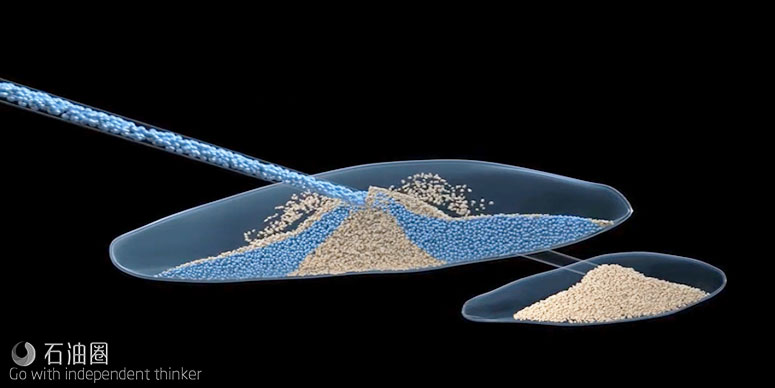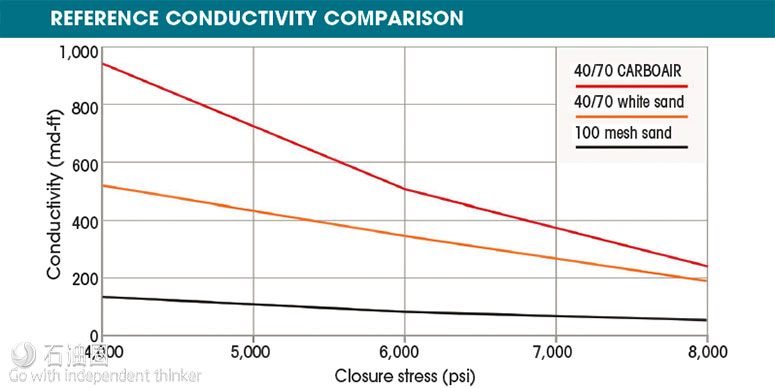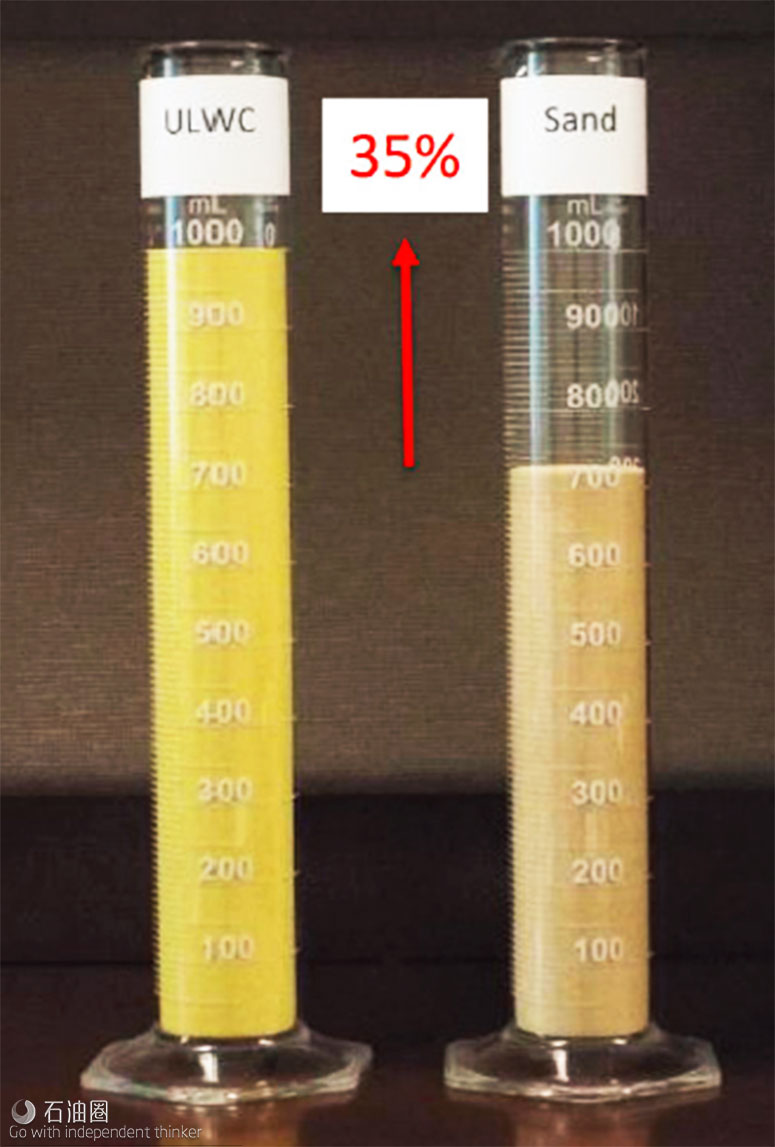Improving Reservoir Contact With A High-transport Proppant
The industry has witnessed a significant growth in the use of slickwater fluid systems in hydraulic fracture design in recent years, with conventional linear gel or crosslinked fluid systems becoming less commonly utilized. The primary drivers of this change in design methodology are cost, proppant pack damage minimization, fracture complexity and environmental footprint.
However, the diminished capability of slickwater systems to effectively suspend and transport proppant in a fracture due to its relatively low viscosity is well known and presents the most significant drawback of utilizing slickwater systems. This problematic transport behavior requires that fracture designs consist of low proppant concentrations (typically 0.25 lb to 2 lb proppant added) and leads to the necessity of very large volumes of fluid for placement. The majority of slickwater completion designs in recent times have incorporated a high percentage of small mesh size proppant (100 mesh and 40/70 mesh) into the pump schedules to afford placement in these thin fluid systems, impacting proppant pack conductivity.
Improving reservoir contact
Fracture conductivity and reservoir contact area (i.e., fracture length) are both contingent on proppant transport and are critical factors that significantly impact the economic viability of a hydraulic fracturing treatment. Proppant that is viable in low viscosity fluids must strike the right balance between lightweight, high-transport features and superior conductivity, primarily in comparison with equivalent sized sand. CARBO adhered to the following performance criteria when developing a new, high-transport, ultralow-density ceramic proppant technology to increase production and EUR from slickwater fracturing operations:
- It must be lighter than sand (for superior proppant transport); and
- It must be more conductive than sand at the closure pressures in which sand finds the most applicability (4,000 psi to 8,000 psi closure pressure).
By virtue of its reduced specific gravity in comparison with sand (2.0 apparent specific gravity ultralightweight ceramic versus 2.65 apparent specific gravity sand), CARBOAIR is a high-transport ceramic proppant developed to increase production and EUR through maximizing reservoir contact and fracture conductivity. It provides approximately 35% more volume with the same mass compared with sand at atmospheric conditions, by virtue of their differences in bulk density (1.15 bulk density CARBOAIR versus 1.56 bulk density sand). It was developed for utilization in low to moderate closure stress reservoir environments. These performance targets were chosen carefully so that the conductivity performance of the proppant could exceed sand at closure pressures in which sand finds the most application (Figure 1).
As such, the proppant can increase the contact area through a larger fracture volume (fracture length and height) without compromising fracture conductivity, and it also can be placed using low viscosity thin fluids.
Higher production, EUR
In nearly every reservoir, the higher fracture contact and conductivity delivered by the proppant results in higher production and EUR. Due to the improved contact, it is possible to utilize more efficient completion designs with fewer stages or smaller fracture designs to deliver the same or increased production, with no increase in authority for expenditure. Any required investment has a rapid payback and will result in a lower finding and development cost per barrel of oil equivalent. To date, the proppant has been pumped in tail-in applications throughout three major basins: the Permian, Northeast and South Texas. Internationally, the proppant has been deployed in an openhole gravel pack in Trinidad, which proved to be operationally successful.
As a lead-in, the proppant can provide increased propped half-length, which increases the drainage area of the fracture. As a tail-in, the proppant will cover more of the productive pay zone and lead to increased production compared to conventional sand, resincoated sand or ceramic proppant.
By alternating the proppant with standard proppant within a fracture stage using slickwater fluids, the technology can provide increased effective propped length as well as full productive zone coverage, leading to additional production and ultimate recovery.
Due to the significantly lower density, 30% less mass of the lightweight ceramic proppant can be used to replace the same volume of sand proppant, thereby reducing the amount of water and chemicals used for the treatment. CARBOAIR proppant also provides more coverage across the pay zone, leading to increased production.
Case study
A second Bone Spring interval test well in the Permian Basin was drilled as a wildcat horizontal based upon vertical openhole log data through an interval of the Bone Spring member from a nearby offset. There had not been another second Bone Spring horizontal test within 15.5 sq km (6 sq miles) of Well A. The lateral section was landed in a 30.4-m (100-ft) section (gross interval) of the second Bone Spring interval bounded between two thick limestone layers, in which a small interval of crossover porosity was recorded. While the electrical log, rotary sidewall cores and mud log data showed high evidence of hydrocarbons, they presented a problem on how to effectively stimulate this thin interval and achieve an economic rate of return. This scenario introduced a great need for incremental propped length as a design objective for optimal oil recovery.
High volumes of nonspecification 100 mesh and 40/70 mesh sand in slickwater (more than 2,000 lb/ft) already had been tested in another second Bone Spring interval well with a thicker gross interval with exceptional results. The primary goal of Well A was to substitute the 40/70 mesh sand with 40/70 CARBOAIR as a way to transport this proppant farther away from the wellbore by utilizing the lightweight characteristics of CARBOAIR and fracture complexity using slickwater fluids to increase contact area and hydrocarbon recovery.
The main operational considerations with pumping 40/70 CARBOAIR and 100 mesh sand were to ensure an accurate sand total was being calculated due to the density differences between CARBOAIR and sand (Figure 2). Two inline densitometers were calibrated and used for these respective sand types, while sand bins on location had the exact amounts of mass required per stage to improve metering accuracy.
The 40/70 CARBOAIR proppant was successfully deployed in a thin section of the second Bone Spring interval. Prefracture modeling results based on completions and reservoir information gathered from the subject well suggested an increase in propped fracture length and propped fracture height of 16% and 40%, respectively, yielding an increase of more than 19% in the contact area. From a well performance standpoint, Well A continues to record steady average monthly production rates and appears to deliver a favorable long-term decline curve from a thinner pay interval. This performance is attributed to the improvement in propped fracture geometry resulting from the utilization of the high-transport proppant.

 石油圈
石油圈


